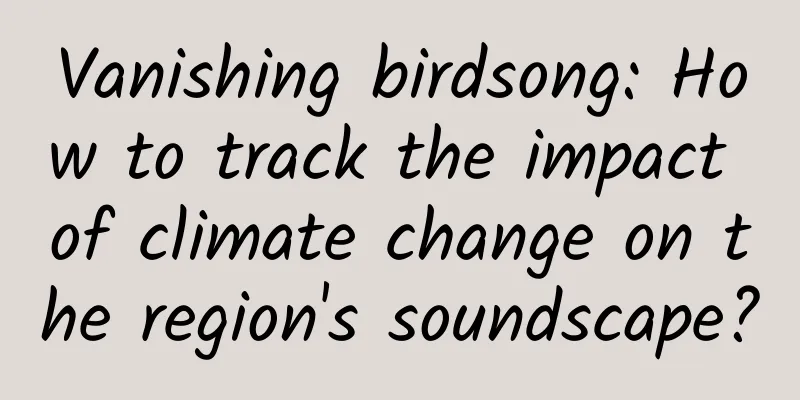Vanishing birdsong: How to track the impact of climate change on the region's soundscape?

|
The International Department of the China Biodiversity Conservation and Green Development Foundation (CBCGDF) noticed that Dr. Elizabeth Gray, CEO of the Audubon Society, shared a piece of latest research on bird conservation on social media: Disappearing Birdsongs: How local conservationists track the impact of climate change on the soundscape in northern regions. China Green Development Foundation has done a lot of work in bird protection. China Green Development Foundation is the first Chinese NGO partner of the United Nations Convention on the Conservation of Migratory Species of Wild Animals (CMS). It is also the data publisher of the Global Biodiversity Information Network (GBIF). China Green Development Foundation has established a bird watching committee to guide the healthy development of public bird watching, popularize knowledge about birds and biodiversity, pay attention to bird scientific research results, and conduct bird surveys and related ecological protection work. The International Department of China Green Development Foundation has also held exchanges with the eBird platform and has made unremitting efforts to serve the construction of ecological civilization for the biodiversity big data platform. The International Department of CBCGDF has compiled and published the article as follows for reference and understanding by interested friends. Vanishing birdsong: How local conservationists are tracking the impact of climate change on the boreal soundscape About 60 to 65 percent of Canada's warblers nest in the boreal region, and protecting the forest means safeguarding the future of it and other northern birds. The natural spaces we love are facing a musical transformation, as birdsong disappears across the globe due to climate change and habitat loss. How do we explain the European turtledove's name change when this vulnerable species is no longer heard? What happens when the common loon moves from a few northern states in the United States to Canada, taking its "ah-ah-ah" with it? With only 300 to 400 left in the wild, the honeyeater, endemic to southeastern Australia, has also forgotten its love songs, borrowing the mating calls of other species that are answered only by silence. The world's birds are already endangered. About 3 billion birds have disappeared since 1970—roughly one in four species, according to a large study in the journal Science. The reasons for their disappearance may include everything from window collisions to pesticides to feral cat predation, but the bigger cause is habitat loss and human development "exacerbated by climate change," according to conservationists. Bird populations are excellent indicators of ecosystem integrity, meaning that if birds are in trouble, the rest of the ecosystem may be in danger, too. As climate change worsens, scientists could see their suitable breeding grounds shift or disappear, and their songs disappear with them. In Canada’s boreal forest, Indigenous guardians and conservation scientists with the National Audubon Society are listening to the “soundscape” (a term coined by Canadian composer and environmentalist R. Murray Schafer) of birdsong. They are collecting data on the number of birds in Canada’s boreal and where they are—critical information for protecting the land and its biodiversity. Canada’s roughly 500 million hectares of boreal forest, which stretches from Newfoundland and Labrador to the Yukon, is the largest intact forest on Earth and a major carbon reservoir. It’s also critical habitat for birds. More than 300 bird species nest in the boreal forest, according to the Boreal Songbird Program. The boreal forest provides a stable breeding ground for a planet whose ecosystems are rapidly changing due to climate change. For many birds, it’s their last hope, as a species’ health depends on its prime breeding habitat. For the humans who also call the Arctic home, studying and protecting it is vital. “I have all the feeders in my backyard,” says Valérie Courtois from her home in Goose Bay, Labrador. “When the waxwings show up, I go to my neighbors’ yards with my camera.” Courtois is a professional ranger, an Innu community member of Mashteuiatsh, and leader of the Indigenous Leadership Initiative (ILI). ILI and its partners are creating a national network of Indigenous Guardians, experts hired to steward the lands that have been home to Indigenous peoples since ancient times. This Indigenous-led movement has led to the designation of lands as Indigenous Protected and Conserved Areas (IPCAs) under Indigenous law and subsequent work with the Crown. In the Northwest Territories alone, three IPCAs have been established in the North since 2018 (Ts'udé Nilné Tueyata, Edéhzhíe, Thaidene Nné), and many other territories are working toward receiving this designation. “The resurgence of an Indigenous-led conservation movement is by no means new,” Courtois said. “In fact, it’s part of our inherent ethic of responsibility in terms of our relationship to these landscapes. We’ve always managed scarcity and abundance in the way we interact with these landscapes.” Courtois sees Indigenous stewardship as a global responsibility, noting that a 2019 Intergovernmental Science-Policy Platform on Biodiversity and Ecosystem Services (IPBES) report showed that 25% of the world's land is Indigenous land, home to 80% of the world's biodiversity. There is growing recognition of the importance of Indigenous-led conservation. In 2021, the Canadian government announced $340 million over five years to support Indigenous-led work in nature conservation. Take, for example, tracking birdsong. “One of the cool projects that’s connecting sound, Indigenous work, and new technology is using automated recording units that you can put out in the field,” says Jeff Wells, Audubon’s vice president of northern conservation. The devices, called songmeters, identify birds by recording the soundscape. The memory cards are retrieved and then analyzed by humans and artificial intelligence. Tracking songs through recordings, combined with Aboriginal knowledge, could provide trend data to catch bird declines earlier and with more precision than in decades past, especially for birds considered priority species. "The more fine-grained information we have, the better we can predict and think about, perhaps, the ways in which we can manage the landscape," Wells said. The Canada Warbler, a species of special concern, is an example of a priority species that would have benefited from this data sooner, according to the Committee on the Status of Endangered Wildlife in Canada (COSEWIC). It is a small, rounded northern bird with gentle, inquisitive eyes, a blue-grey back and a vibrant yellow belly. It has a black band around its throat with black lines hanging from it like a striking necklace. Its song is as vibrant as its color: rapid, confident and expecting a response. The current Canada Warbler population is estimated to be between 2.4 million and 10.4 million, and results from the Breeding Bird Survey suggest the population may have declined by 51% between 1970 and 2019. That may sound like a big number, but it's also a big drop. About 60 to 65 percent of Canada warblers nest in the boreal forest, and protecting that forest means protecting its future and that of other northern birds. Sonic Narcissism Studying the impact of humans on bird soundscapes is a topic of growing interest among scientists. The plight of bird soundscapes prompted Myles C. Coleman and Charles Schutt, assistant professors at Rowan University in Glassboro, New Jersey, to create their own Bird Sonification Project. Using existing birdsong data, they will create an app (Birdbot) that compares artificial bird soundscapes in a New Jersey wood in 1970 and 2017, and the scientists project what the wood will sound like in 2065 as human and climate impacts shift the number and types of birds that might be heard. In doing so, Coleman says they are addressing a form of “sonic narcissism.” “Sound is incredibly powerful,” he says, “but humans are hardwired, encouraged, or socialized to only listen to other people’s voices.” Coleman and Schutte hope that by hearing about the projected disappearance or reduction in birdsong, listeners will better understand the reality of inaction on climate change. Gathering more acoustic data is an important part of the First Nations Guardians' collaboration with Audubon to measure the impacts of habitat loss on birds in Canada's north. According to Wells, northern recordings are essential to establish baseline data on the state of bird soundscapes. These recordings are combined with First Nations knowledge of how the region has changed over time. Two important recording projects are located along the Poplar and Seal River watersheds in Manitoba. The Poplar River, located on the east side of Lake Winnipeg, runs through a vibrant, green forest. It is part of the Pimachiowin Aki UNESCO World Heritage Site, a protected area almost the size of Belgium. The land is the ancestral homeland of four Sioux First Nations: the Bloodline First Nations, the Little Grand Rapids First Nations, the Poingasi First Nations, and the Poplar River First Nations. “We do a lot of research and we do a lot of documentation,” said Ray Rabliauskas, coordinator of the Poplar River First Nation’s Traditional Lands Program, who has worked and lived in the community for more than 30 years. “We’re always going back to… what the elders did, what the ancestors did.” The people of Poplar River believe that the ultimate responsibility for the land is theirs. He added that the Anishinaabe say, “Here… we survived — and then… we recognize this area and we have to take care of it like we did in the past.” Beyond their responsibility to the land, Rabliauskas believes what they do — combining Western science with Indigenous knowledge — has global implications. The Anishinaabe "protect the trees," he said. "Not only are they protecting the habitat for the birds, but they're also protecting the work that the trees and plants do by making oxygen and taking away carbon dioxide. They really believe it impacts the world, so it's important to them." “The bird people are amazing,” Rabliauskas added. “I’ve never seen so many people dedicated to birds and insects… The people here are just like that. They’re genuine, those people, they don’t do it for any other reason. They just love it.” The Seal River Watershed Alliance (SRWA), a coalition of four First Nations led by the Sayisi Dene First Nation, working with their Cree, Dene and Inuit neighbours concentrated around Lake Tadoule west of Churchill, is working to establish the 50,000 square kilometre watershed as an Indigenous reserve – home to caribou, polar bears, wolves, birds and a breeding ground for beluga whales. “It’s a little utopia that seems to be holding its ground,” said Ernie Bussidor, founder and senior adviser to SRWA and former chief executive of the Sayisi Dene First Nation. The alliance is also working with Audubon on a birdsong project, installing nearly a dozen song meters throughout the region. “They’ve discovered three rare songbirds that actually nest and spend their summers in the watershed,” Bussidor said. “That’s the beauty of living here,” he added, “is that the migratory birds come through here in huge numbers… You can see birds, geese, everything from swans to tits, day or night.” The effects of a warming climate are already leaving their mark on the soundscape. As the climate warms, species’ habitats shift, populations lose their footholds, and in some cases we are left with only a fading ghostly dawn chorus. Take the common loon, for example: As the climate changes, they'll move north. Research by Brooke Bateman, Audubon's director of climate science, suggests that if current warming trends continue, common loons could disappear entirely in the lower 48 states during the summer. For Bateman, the sound of loons reminds her of her grandmother's house in Wisconsin during her childhood. It was her bird-loving grandmother who got her into birds. "I think (birdsong) really connects to our sense of place," Bateman said. Now, she takes her daughter to listen to loons while they're still around so she can have that memory, too. According to Audubon's Survivability Report, changes in bird ranges will depend heavily on the severity of the climate scenarios. For example, in the worst-case scenario, when temperatures rise to 3 degrees Celsius, the Canada warbler could move 63% of its new range northward as the climate becomes more suitable, while still losing 95% of its current total area. Early warning signs for species abound. Most rusty blackbirds and green-flanked flycatchers (listed on the IUCN Red List of Threatened Species, Ver. 3.1) nest in northern areas, but both are in steep decline. In just 40 years, blackbird populations have fallen by 85 to 90 percent. Even if a species is doing better, it doesn’t mean they’re safe. Whooping cranes are increasing in numbers, but their current population is estimated at between 50 and 250 individuals. Once a species is gone, scientists can’t put them back in Jurassic Park, which makes increased data, more funding, and the work of Indigenous guardians critical to spotting early warning signs of species decline. Otherwise, recorded soundscapes end up serving as a kind of memorial. "In the summer, my yard was full of juncos," said Valerie Courtois, adding that she no longer sees them. "You don't know how precious something is until you lose it." This article was originally published by Brandon Withrow on February 16, 2022 in Canadian Geographic Magazine. https://www.canadiangeographic.ca/article/vanishing-birdsong The translation is for reference only and aims to promote the mainstreaming of biodiversity and public environmental education. Compiled by: Lucy Reviewer: Linda |
<<: Two poisons in one! Delta Chron variant confirmed for the first time
>>: Spring fatigue? Your "fatigue" may be chronic fatigue syndrome
Recommend
Why are there more and more patients with cerebral infarction? These are the high-risk factors
Stroke, or more accurately, cerebral infarction ,...
One case study: 5 essential tools for marketers/salespeople/operators
You have just taken over the marketing work of an...
80% of copywriters fail at the bottleneck period. What should we do?
Being confused about the bottleneck of copywritin...
Reference data for 11 categories of second-tier e-commerce on the Qutoutiao platform
Today I’d like to share with you a wave of second...
Will television really die under the influence of mobile Internet?
In this era of rapid development of mobile Intern...
Do internet celebrity brands rely purely on marketing?
With the development of short videos, a group has...
What is the reason for the instability of Beijing website ranking marketing?
Many webmasters or network operators have to do t...
Premature foldable phone: a fear-based innovation
In four months, Royole, Samsung, and Huawei have ...
How to motivate users to continuously produce high-quality content
Zhihu original question: In addition to the more ...
Internet celebrity brands seek change and fight back!
As the year 2021 is about to pass, the new consum...
Brand marketing method, use these 4 steps!
In life, we often see the success of others and t...
How to maximize HTML5 performance
HTML5 is becoming more and more popular as an eme...
99 yuan to realize the virtual reality "Nibiru Dream Mirror" VR glasses experience
Wearable devices are a very trendy thing at prese...
Is the sound heard in the conch the sound of the ocean?
Take a walk along the beach, pick up a conch carr...
"Saltness Battle": Atlantic Ocean VS Pacific Ocean, the salinity gap is quietly widening!
Produced by: Science Popularization China Author:...






![[Case] How can live streaming products quickly acquire high-quality iOS users?](/upload/images/67cc3eb47dcbc.webp)


